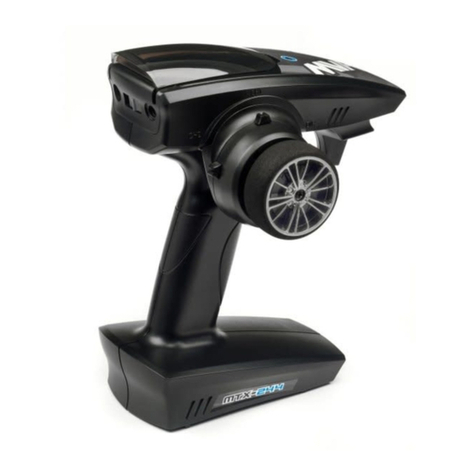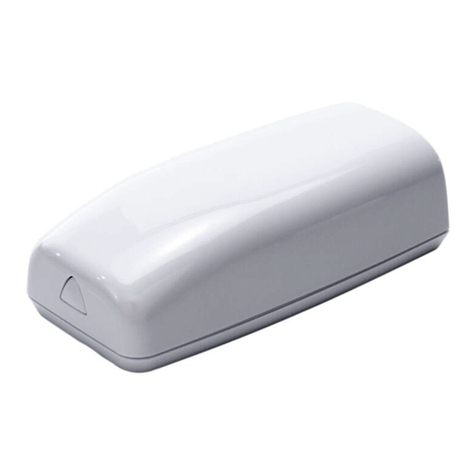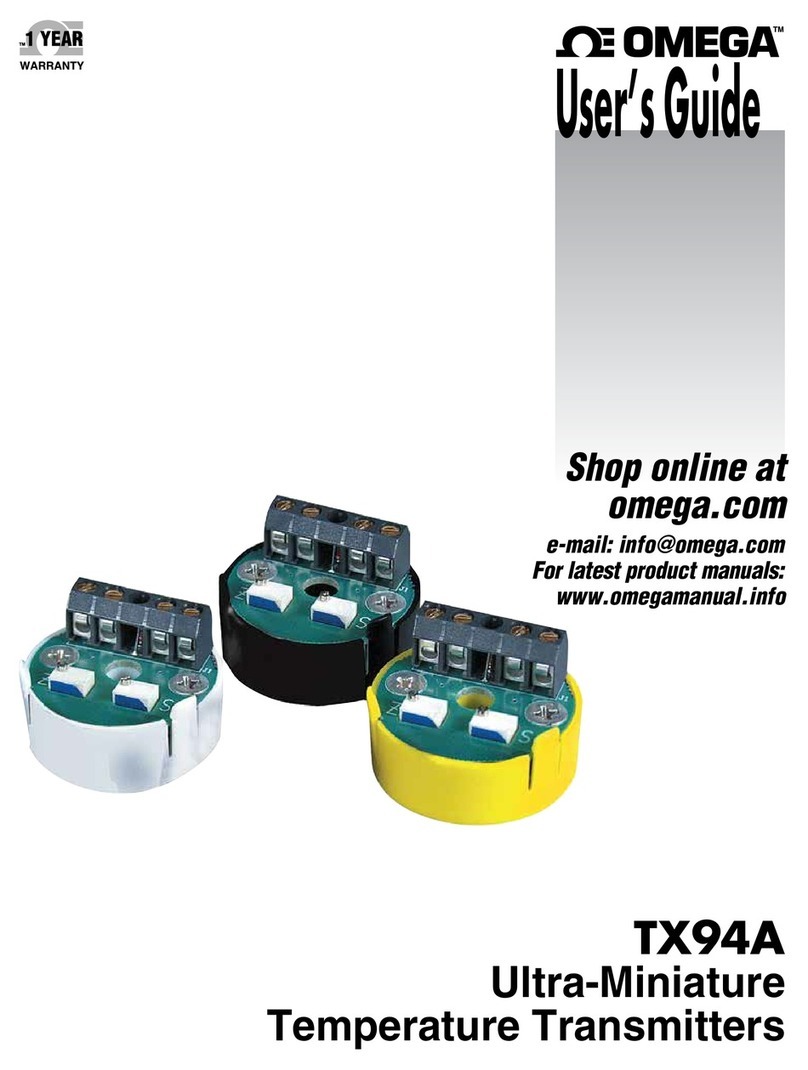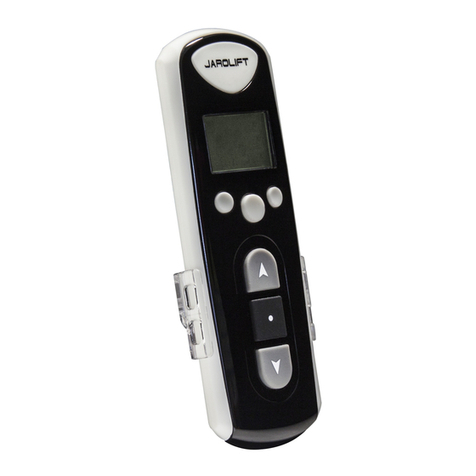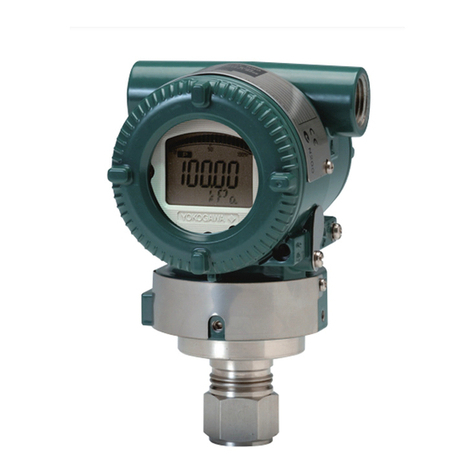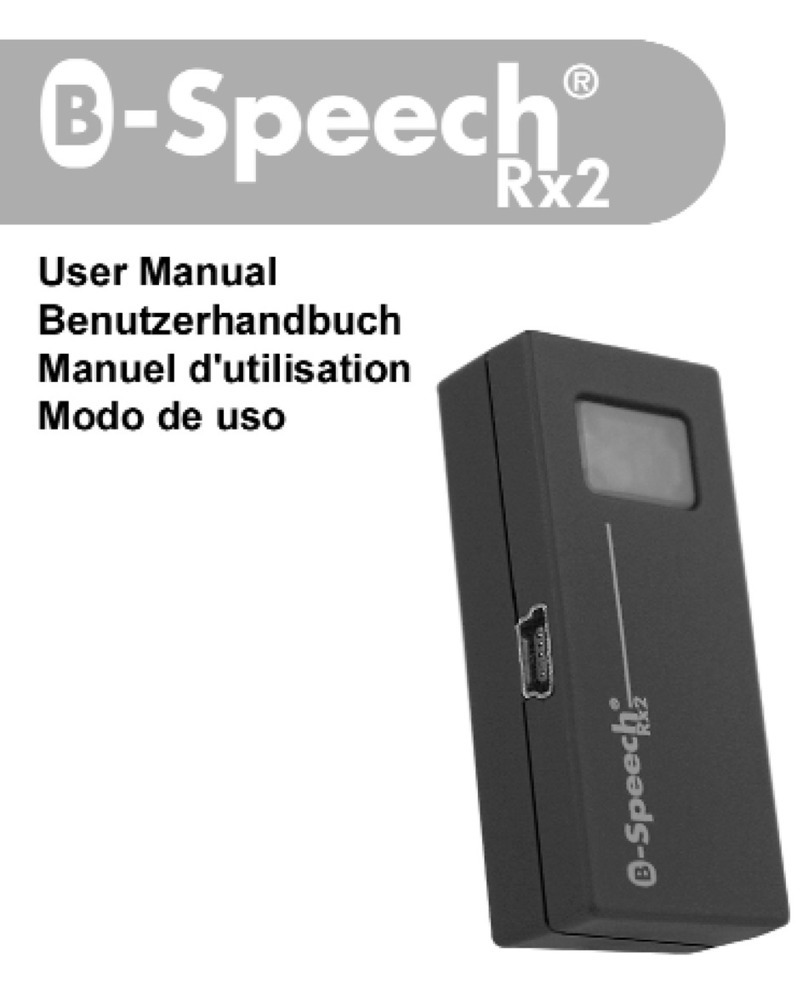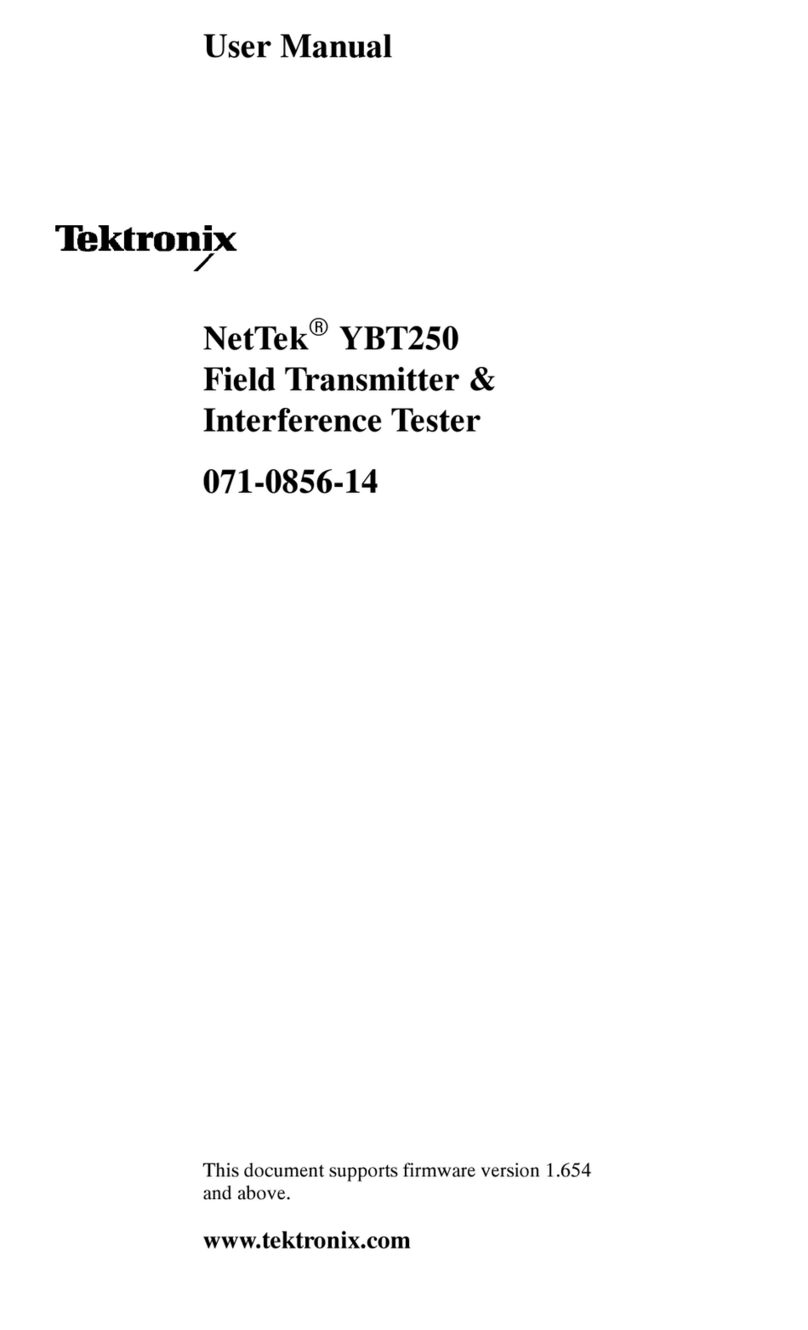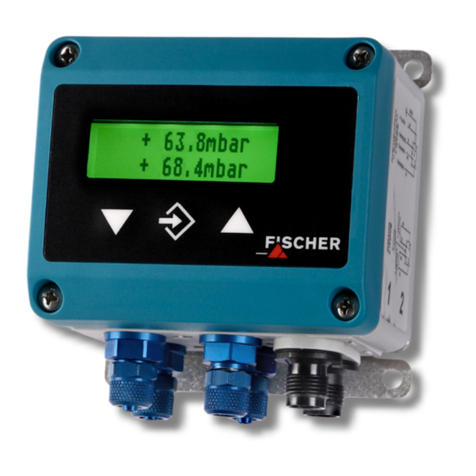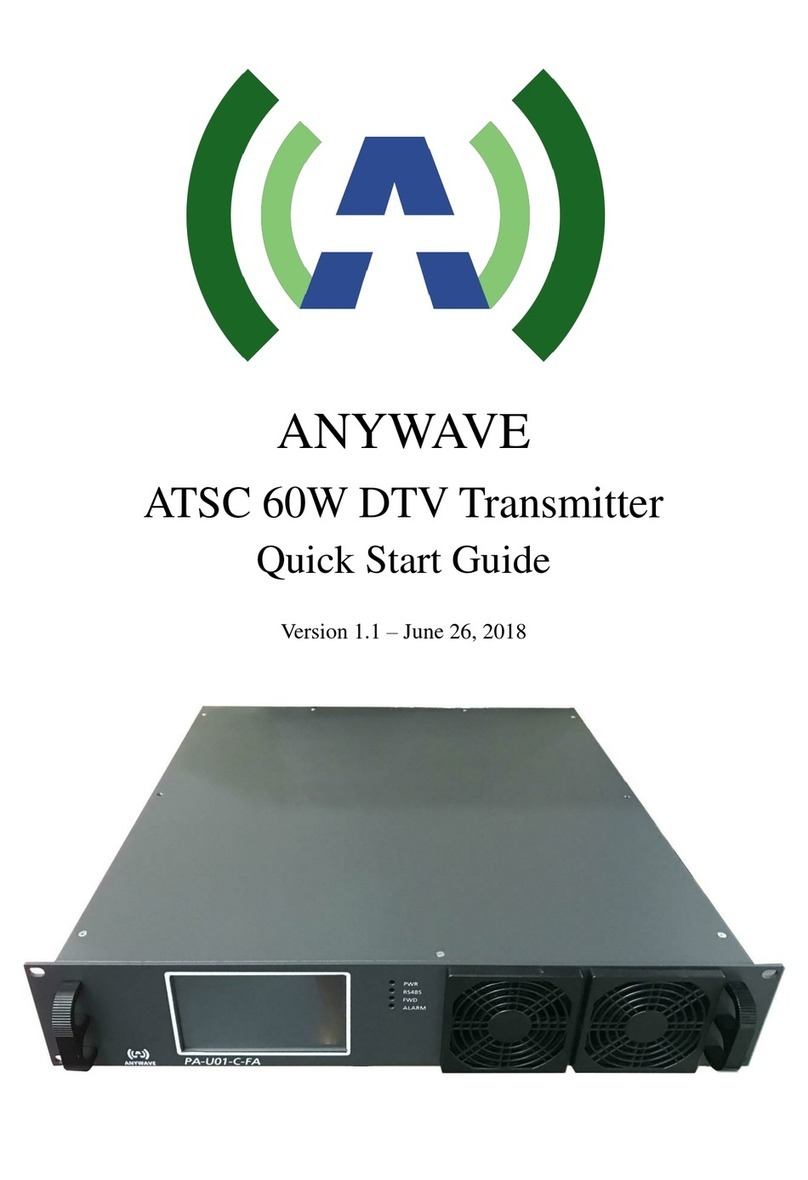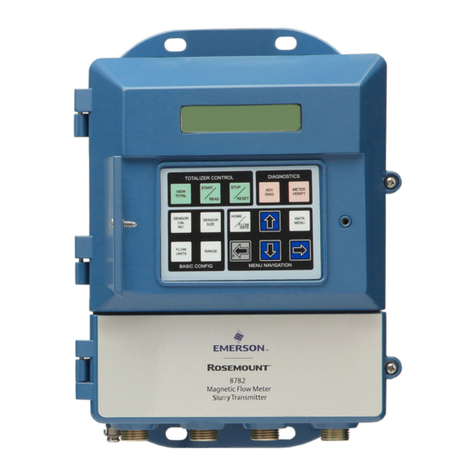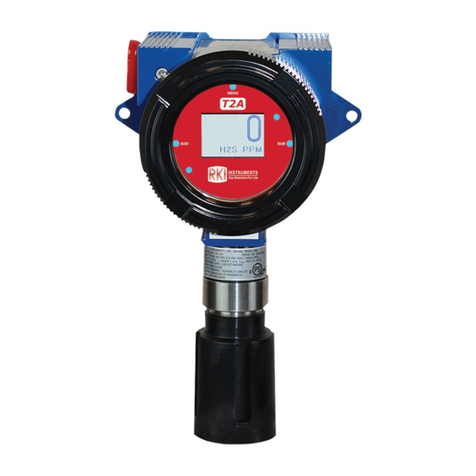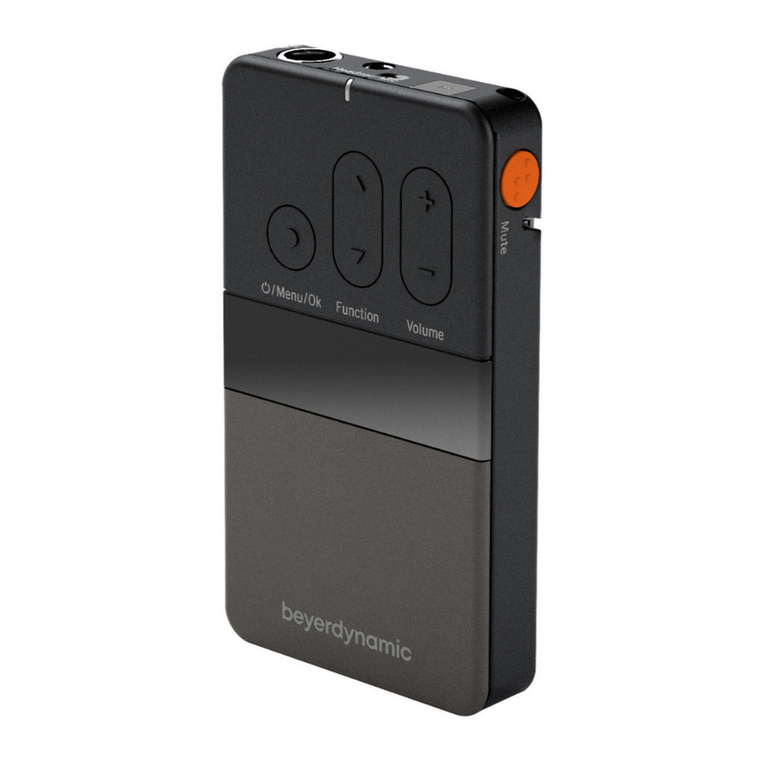Tek-Trol TEK-W AVE 4300C User manual

Technology Solutions
TAVE 4300C
EK-W
Instruction Manual
Free Space Radar Level Transmitter
Document Number: IM-4300C
www.tek-trol.com

© COPYRIGHT Tek-Trol LLC 2020
NOTICE
Read this manual before working with the product. For personal and system safety, and for optimum
product performance, make sure you thoroughly understand the contents before installing, using, or
maintaining this product.
For technical assistance, contact
Customer Support
796 Tek-Drive
Crystal Lake, IL 60014
USA
Tel: +1 847 857 6076
www.tek-trol.com
No part of this publication may be copied or distributed, transmitted, transcribed, stored in a
retrieval system, or translated into any human or computer language, in any form or by any means,
electronic, mechanical, manual, or otherwise, or disclosed to third parties without the express
written permission. The information contained in this manual is subject to change without notice.

TechnologySolutions
Instruction Manual
Tek-Wave 4300C
www.tek-trol.com
1
Table of Contents
1Safety Instructions ...........................................................................................................................2
1.1 Intended Use ........................................................................................................................................2
1.2 Safety Instructions from the Manufacturer ............................................................................................2
1.2.1 Disclaimer..................................................................................................................................................... 2
1.2.2 Product Liability and Warranty .................................................................................................................... 2
1.2.3 Information Concerning the Documentation .............................................................................................. 2
1.3 Safety Precautions ................................................................................................................................ 2
1.4 Packaging, Transportation and Storage.................................................................................................. 3
1.4.1 Packaging ..................................................................................................................................................... 3
1.4.2 Transportation ............................................................................................................................................. 3
1.4.3 Storage ......................................................................................................................................................... 3
1.4.4 Nameplate.................................................................................................................................................... 3
2Product Description..........................................................................................................................4
2.1 Introduction ......................................................................................................................................... 4
2.2 Working Principle .................................................................................................................................4
2.3 Specifications........................................................................................................................................5
2.4 Dimensional Drawings ..........................................................................................................................6
2.5 Model Chart..........................................................................................................................................7
3Installations .....................................................................................................................................7
3.1 Mounting Position ................................................................................................................................8
3.2 Installation at Conical Tank ................................................................................................................... 8
3.3 Incorrect Installation.............................................................................................................................9
4Electrical Connection...................................................................................................................... 11
4.1 Wiring Connection .............................................................................................................................. 11
4.2 Protection Level.................................................................................................................................. 12
5Operation....................................................................................................................................... 13
5.1 Instrument Commissioning.................................................................................................................. 13
5.1.1 Different Debugging Method..................................................................................................................... 13
5.2 Display or Adjustments ....................................................................................................................... 14
5.3 Menu.................................................................................................................................................. 15
5.3.1 Program Operations................................................................................................................................... 15
5.3.2 Edit Parameter ........................................................................................................................................... 15
5.3.3 Menu Instruction ....................................................................................................................................... 16
6Menu Tree ..................................................................................................................................... 31

TechnologySolutions
Instruction Manual
Tek-Wave 4300C
www.tek-trol.com
2
1Safety Instructions
1.1 Intended Use
Tek-Wave 4300C Free Space Radar Level Transmitter is widely used to measure level of tanks, lakes,
rivers or streams.
1.2 Safety Instructions from the Manufacturer
1.2.1 Disclaimer
The manufacturer will not be held accountable for any damage that happens by using its product,
including, but not limited to, direct, indirect, or incidental and consequential damages. Any product
purchased from the manufacturer is warranted by the relevant product documentation and our Terms
and Conditions of Sale. The manufacturer has the right to modify the content of this document of any
time with any reason without prior notice and will not be answerable for the possible consequence
of changes.
1.2.2 Product Liability and Warranty
The operator shall have authority for the suitability of the device for the specific application. The
manufacturer accepts no accountability for the consequences of misuse by the operator. A wrong
installation or operation of the devices (systems) will cause the warranty to be void. The respective
Terms and Conditions of Sale, which forms the basis for the sales contract, shall also apply.
1.2.3 Information Concerning the Documentation
To prevent any injury to the operator or damage to the device, it is essential to read the information
in this document and the applicable national standard safety instructions. This operating manual
consists of all the information that is required in various stages, such as product identification,
incoming acceptance and storage, mounting, connection, operation and commissioning,
troubleshooting, maintenance, and disposal.
1.3 Safety Precautions
You must read these instructions carefully before installing and commissioning the device. These
instructions are an essential part of the product and must be kept for future reference. Only by
observing these instructions, optimum protection of both personnel and the environment, as well as
safe and fault-free operation of the device can be ensured. For additional information that is not
discussed in this manual, contact the manufacturer.
The following safety symbol marks are used in this operation manual and on the instrument.
WARNING
Indicates a potentially hazardous situation which, if not avoided, could result in
death or severe injury
CAUTION
Indicates a potentially hazardous situation which, if not avoided, may result in
minor or moderate injury. It may also be used to alert against unsafe practices.

TechnologySolutions
Instruction Manual
Tek-Wave 4300C
www.tek-trol.com
3
NOTE
Indicates that operating the hardware or software in this manner may damage it
or lead to system failure.
1.4 Packaging, Transportation and Storage
1.4.1 Packaging
The original package consists of
1. Tek-Wave 4300C Free Space Radar Level Transmitter
2. Documentation
NOTE
Unpack and Check the contents for damages or sign of rough handling. Report
damage to the manufacturer immediately. Check the contents against the packing
list provided.
1.4.2 Transportation
•Avoid impact shocks to the device and prevent it from getting wet during transportation.
•Verify local safety regulations, directives, and company procedures with respect to hoisting,
rigging, and transportation of heavy equipment.
•Transport the product to the installation site using the original manufacturer’s packing
whenever possible.
1.4.3 Storage
If this product is to be stored for an extended period of time before installation, take the following
precautions:
•Store your product in the manufacturer’s original packing used for shipping.
•The storage location should comply with the following requirements:
oFree from rain and water
oFree from vibration and impact shock
oAt room temperature with minimal temperature and humidity variation
•Before storing a used flow meter, remove any fluid from the flow meter line completely.
Properties of the instrument can change when stored outdoors.
1.4.4 Nameplate
The nameplate lists the order number and other important information, such as design details and
technical data.
NOTE
Check the device nameplate to ensure that the device is delivered according to your
order. Check for the correct supply voltage printed on the nameplate.

TechnologySolutions
Instruction Manual
Tek-Wave 4300C
www.tek-trol.com
4
2Product Description
2.1 Introduction
Tek-Wave 4300C Free Space Radar Level Transmitter is 26GHz high frequency radar type level
measuring instrument, which can measure up to 70 meters. The antenna is furthered optimized and
the new fast microprocessor can carry out signal analysis and processing at a higher rate, therefore the
Tek-Wave 4300C Free Space Radar Level Transmitter can be used for some complex measurement
conditions such as reactor, solid bin etc.
2.2 Working Principle
The Tek-Wave 4300C Radar Level antenna transmits a narrow microwave pulse, which is transmitted
downward through the antenna. When the microwave contacts the surface of the medium, it reflected
and received by antenna again. This received signal transmitted to electronic circuit and converted into
the material level signal.
Fig 1: Tek-Wave 4300C Free Space Radar Level Transmitter
Where, A is Range Setting
B is Low Level Adjustment
C is High Level Adjustment
D is Blind Area Range

TechnologySolutions
Instruction Manual
Tek-Wave 4300C
www.tek-trol.com
5
2.3 Specifications
Accuracy ±3mm
Measuring Range 90ft (30m)
Microwave Frequency 26GHz
Maximum Pressure Max. 580psi (4Mpa)
Process Pressure -14.50 to 580psi (0.1 to 4Mpa)
Operating Temperature -40 to 212°F (-40 to 100°C)
Process Temperature -40 to 482°F (-40 to 250°C)
Medium Temperature -40 to 300°F (-40 to 150°C)
Shock Resistance Mechanical vibration 32.80ft/s2(10m/s2), 10 to 150 Hz
Process Connection NPT or Flange
Electrical Connection ½” NPT (Two)
Terminal Block 18 to 22 AWG Wire
Protection Class IP67
Output Signal 4 to 20mA with HART® Optional Modbus RS485
Fault Signal
current output unchanged.
20.5mA; 22mA; 3.9mA
Integration time 0 to 50s adjustable
Power Supply 16 to 26VDC
Power Consumption Max 22.5mA/1w
Permissive Ripple
- <100Hz Uss<IV
- (100 to 100K) Hz Uss<I0mV
Blind Area Antenna end
Response Time About 1 second (depending on parameter setting)
Display LCD
Display Resolution 1mm
Approval CE

TechnologySolutions
Instruction Manual
Tek-Wave 4300C
www.tek-trol.com
6
2.4 Dimensional Drawings
Fig 2: Front View Fig 3: Side View
Fig 4: Top View
Fig 5: Tek-Wave 4300C Free Space Radar Level Transmitter
Line Size
in (mm)
D
in (mm)
H
in(mm)
2” (50)
1 ¾” (φ46)
5 ½” (140)
2”NP T
H
D
Ø5”
(125mm)
M20x1.5
2 3⁄4”
(66mm)
½” NPT

TechnologySolutions
Instruction Manual
Tek-Wave 4300C
www.tek-trol.com
7
2.5 Model Chart
Example Tek-Wave 4300C 1 A 1 A 1 A 1 Tag Tek-Wave 4300C-01-A-01—A-01-A-01-Tag
Series Tek-Wave 4300C
Free Space Radar Level Transmitter
Output 1
4-20mA, HART (2-wire)
2
Modbus RS-485 (4-wire)
Pressure Limits
A
-14.5 to 580psi (0.1 to 4Mpa)
X
Special
Temperature Limits
1
Standard: -40 to 300°F (-40 to 150°C)
2
High: -40 to 482°F (-40 to 250°C)
Process Connection
A
2” NPT
B
3" 150# Flange
C
4" 150# Flange
D
3" 300# Flange
X
Special
Electrical
Connection
1
½” NPT (Two)
X
Special
Power Supply
A
16 to 26VDC
X
Special
Range
1
90 feet (30 Meters)
Options
TAG SS Tag
FC Factory Configuration
3Installations
This section covers instruction on installations and commissioning. Installations of the device must be
carried out by trained, qualified specialists authorized to perform such works.
CAUTION
•When removing the instrument from hazardous processes, avoid direct contact
with the fluid and the meter.
•All installation must
comply with local installation requirements and local
electrical code

TechnologySolutions
Instruction Manual
Tek-Wave 4300C
www.tek-trol.com
8
3.1 Mounting Position
Fig 6: Installation at 1/4 or 1/6 of Diameter
•Install at 1/4 or 1/6 of the diameter.
•Minimum distance of 8” (200mm) between instrument and vessel all during installation
3.2 Installation at Conical Tank
Fig 7: Installation at Conical Tank in Top Plane
•The conical tank's top plane can be installed in the middle of the tank top to ensure that the cone
bottom can be measured.
Fig 8: Installation at Conical Tank in inclined Plane
1
Reference Plane
2
Vessel Center or Symmetrical Axis

TechnologySolutions
Instruction Manual
Tek-Wave 4300C
www.tek-trol.com
9
•When there is a material pile, the antenna must be vertically aligned with the material surface.
•If the material surface is uneven, the angle of the horn must be adjusted by the universal flange
to align the horn with the material surface as much as possible (because the inclined solid surface
may cause echo attenuation or even signal loss).
3.3 Incorrect Installation
•The conical tank cannot be installed above the feed port.
CAUTION
Sunshade and rainproof measures shall be taken during outdoor installation.
Fig 9: Installation at Conical Tank
•When there is an obstacle in the tank that affects the measurement, installing a reflection plate
for normal measurement is necessary.
Fig 10: Installation of Reflection Plate
•The instrument shall not be installed in the middle of the arch or round tank top.

TechnologySolutions
Instruction Manual
Tek-Wave 4300C
www.tek-trol.com
10
•Indirect echo will be affected by multiple echoes.
•Multiple echoes may have a larger signal threshold than real echoes because multiple echoes can
be concentrated through the top. Therefore, it cannot be installed in the center position.
Fig 11: Installation at Round Tank
•Height requirement of connecting pipe: the antenna must extend at least 3/8” (10mm) into the
tank.
Fig 12: Installation with Height Requirement
3⁄”
(10mm)

TechnologySolutions
Instruction Manual
Tek-Wave 4300C
www.tek-trol.com
11
4Electrical Connection
This section covers all electrical connection requirement. Electrical connection of the device must be
carried out by trained, qualified specialists authorized to perform such work by the installation site.
WARNING
•Connect all electrical cables when the power is switched off. If the device does
not have switch-off elements, then, overcurrent protection devices, lightning
protection and/or energy isolating devices must be provided by the customer.
•The device must be grounded to a spot in accordance with regulations in order
to protect personnel against electric shocks.
NOTE
When using the measuring device in hazardous areas, installation must comply with
the corresponding national standards and regulations and the Safety Instructions or
Installation or Control Drawings.
4.1 Wiring Connection
•4 to 20mA or Hart (two-wire system) power supply and output current signal share a two-core
shielded cable.
•Refer to technical data for specific power supply voltage range.
•A safety barrier should be placed between the power supply and instrument for an intrinsically
safe version.
•Standard 2- wire cable with an outside diameter of 5...9mm is used to assures the sealing
effect of cable entry. It can be used as a feeder cable.
•You are recommended to use screened cables in electromagnetic Connection cable with
special earth wire used as feeder cable.
Fig 13: Two-Wire System Wiring Diagram
•RS485/MODBUS power supply and MODBUS signal line respectively use a shielded cable.
•Refer to the technical data for the specific power supply voltage range.
+ -
+
-
(4 20)
~m A
1 2

TechnologySolutions
Instruction Manual
Tek-Wave 4300C
www.tek-trol.com
12
Fig 14: 24V RS485/Modbus Wiring Diagram
NOTE
•Please observe the requirements of the local electrical installation regulations!
•
Please observe the local regulations on the health and safety of personnel. All
operations of electrical components of instruments must be completed by
professional personnel who have received formal training.
•Ple
ase check the nameplate of the instrument to ensure that the product
specifications meet your requirements. Please ensure that the supply voltage is
consistent with the requirements on the instrument nameplate.
4.2 Protection Level
•The Tek-Wave 4300A Free Space Radar Level Transmitter fully meets the requirements of
protection grade IP66/67.
•Please ensure the water resistance of cable sealing head as shown in figure 15:
Fig 15: Protection Level
•How to ensure that the installation meets the requirements of IP67:
oMake sure that the sealing head is not damaged.
oMake sure the cable is not damaged.
+ -
+
-
(6 24)
~v D C
1 2 34 5
RS 4 85
1
2
3

TechnologySolutions
Instruction Manual
Tek-Wave 4300C
www.tek-trol.com
13
oMake sure that the cables are used to meet the requirements of the electrical connection
specifications.
oBefore entering the electrical interface, bend the cable downward to ensure that the water
will not flow into the shell, see 1
oPlease tighten the cable sealing head, see 2
oPlease block the unused electrical interface with a blind plug, see 3
5Operation
5.1 Instrument Commissioning
5.1.1 Different Debugging Method
•Display or Key
•Upper computer debugging
•Hart hand programmer
5.1.1.1 Display or Key
•The instrument is debugged by four buttons on the display screen.
•The language of the debug menu is optional.
•After debugging, it is generally used for display and the measured value can be read out very
clearly through the glass window.
Fig 16: Display or Key
1
Display
2
Key

TechnologySolutions
Instruction Manual
Tek-Wave 4300C
www.tek-trol.com
14
5.1.1.2 Upper Computer Debugging
Connect to the upper computer through HART
Fig 17: Connection to the computer through HART
5.1.1.3 HART Handheld Programmer Programming
Fig 18: HART Handheld Programmer
5.2 Display or Adjustments
•Adjustments can be done with four buttons on the view point.
•Optional menu languages are available.
•View point is only used for display after adjustments.
•Measurement results would be displayed on the LCD.
24VDC
1
2
3
4
24VDC
1
2
3
1
RS232 interface / USB interface
2
Tek-Wave 4300C Free Space
Radar Level Transmitter
3
HART adapter
4
250Ω resistance
1
HART Hand Programmer
2
Tek-Wave 4300C Free Space
Radar Level Transmitter
3
250Ω resistance

TechnologySolutions
Instruction Manual
Tek-Wave 4300C
www.tek-trol.com
15
Fig 19: Display of Tek-Wave 4300C
Table 1: Display Keys and its function
Display Key
Function
Enter programming mode;
Confirm programming options and modifications to parameters
Modify parameter values and select display mode
Select programming options and digit of parameters to edit;
Display the contents of parameters
Exit programming mode and return to higher menu level;
Display Echo Wave
5.3 Menu
5.3.1 Program Operations
•Enter program mode by press.
•Press after each parameter modify; Otherwise the modification will be abandoned.
•Press to quit program status.
5.3.2 Edit Parameter
•The first digit of the edit parameter is displayed in black background.
•Modify digit with .
•Edit next digit with .
•After editing, press to confirm and store the mod.
•Some settings can be done by selecting one of seeing optional menus and press to
confirm.
OK
BK
OK
OK
BK
OK
OK

TechnologySolutions
Instruction Manual
Tek-Wave 4300C
www.tek-trol.com
16
5.3.3 Menu Instruction
5.3.3.1 Basic Settings
•These setting s are basic setup of the sensor such as minimum and maximum adjustment,
medium, damping etc.
•Press to bring the sensor to program mode from run mode. Then the menu is displayed as
shown below
*Note: The menu item number is displayed on the top right corner.
5.3.3.1.1 Minimum Adjustment
•Minimum adjustment setting regulates the linear scaled current output.
•At main menu, select basic settings with and press to confirm.
•Press for edit the percentage value.
•Press again to confirm the modification and furthermore you can edit the corresponding
distance value please refer edit parameter section to edit parameters.
5.3.3.1.2 Maximum Adjustments
•Maximum adjustment setting regulates the linear scaled current output.
•At main menu, select basic settings with and press to confirm.
•Press for edit the percentage value.
•Press again to confirm the modification and furthermore you can edit the corresponding
distance value please refer edit parameter section to edit parameters.
OK
OK
OK
OK
OK
OK
OK

TechnologySolutions
Instruction Manual
Tek-Wave 4300C
www.tek-trol.com
17
5.3.3.1.3 Medium
•Each medium has different reflective properties.
•This menu is used to set the medium to be solid or liquid and another relative factor.
•Move arrow with .
•Solid or liquid medium can be selected.
•Press to confirm the selection and enter Fast level change submenu.
Fast Level Change
oPress to enter Fast Level Change Confirmation.
oMove arrow with to Select Yes or No for Fast level change.
oPress to confirm the selection
First Echo
OK
OK
OK

TechnologySolutions
Instruction Manual
Tek-Wave 4300C
www.tek-trol.com
18
oPress to enter First Echo menu.
oPress to select to way to set First Echo
oThere are five ways to set First Echo
Normal: No adjustments on first echo
Small: Decrease first echo by 10dB
Big: Increase first echo by 10dB
Bigger: Increase first echo by 20dB
Biggest: Increase first echo by 40dB
Agitated Surface or Large Angler Repose
oPress to enter Agitated surface or Large angler repose menu.
oPress to move the arrow, select whether the liquid surface is fluctuating or
whether the solid is a large number of angles.
oPress to confirm the selection.
Foaming or Powder Dust
oPress to enter the submenu of foaming or powder dust confirmation.
OK
Table of contents
Other Tek-Trol Transmitter manuals

Tek-Trol
Tek-Trol TEK-FLEX 4100A User manual
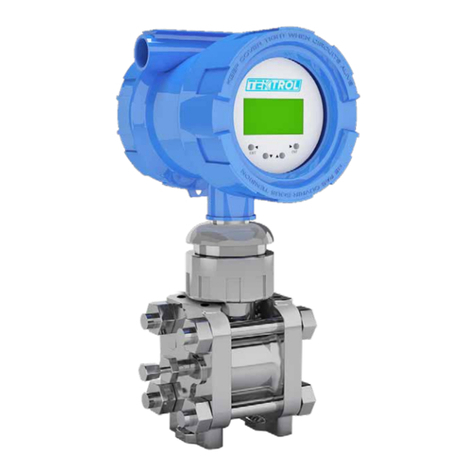
Tek-Trol
Tek-Trol TEK-BAR 3800XP User manual
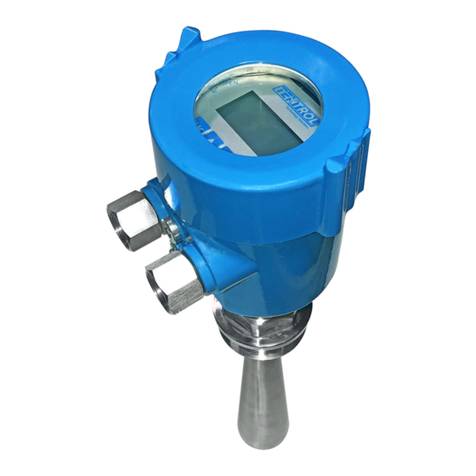
Tek-Trol
Tek-Trol TEK-WAVE 4300C User manual
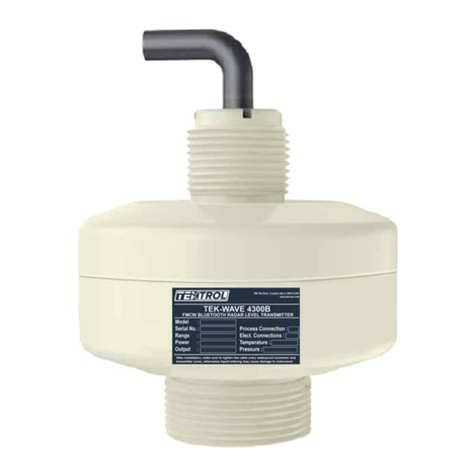
Tek-Trol
Tek-Trol TEK-WAVE 4300B User manual
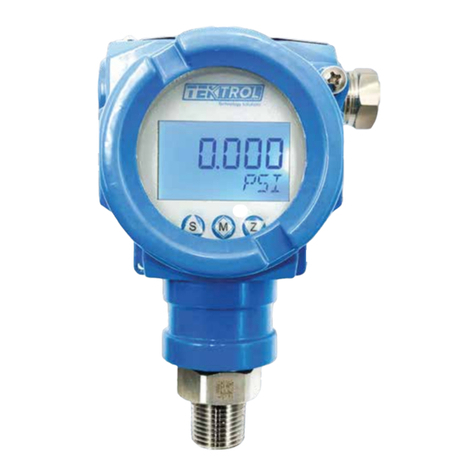
Tek-Trol
Tek-Trol TEK-B AR 3120B User manual

Tek-Trol
Tek-Trol TEK-WAVE 4300B User manual
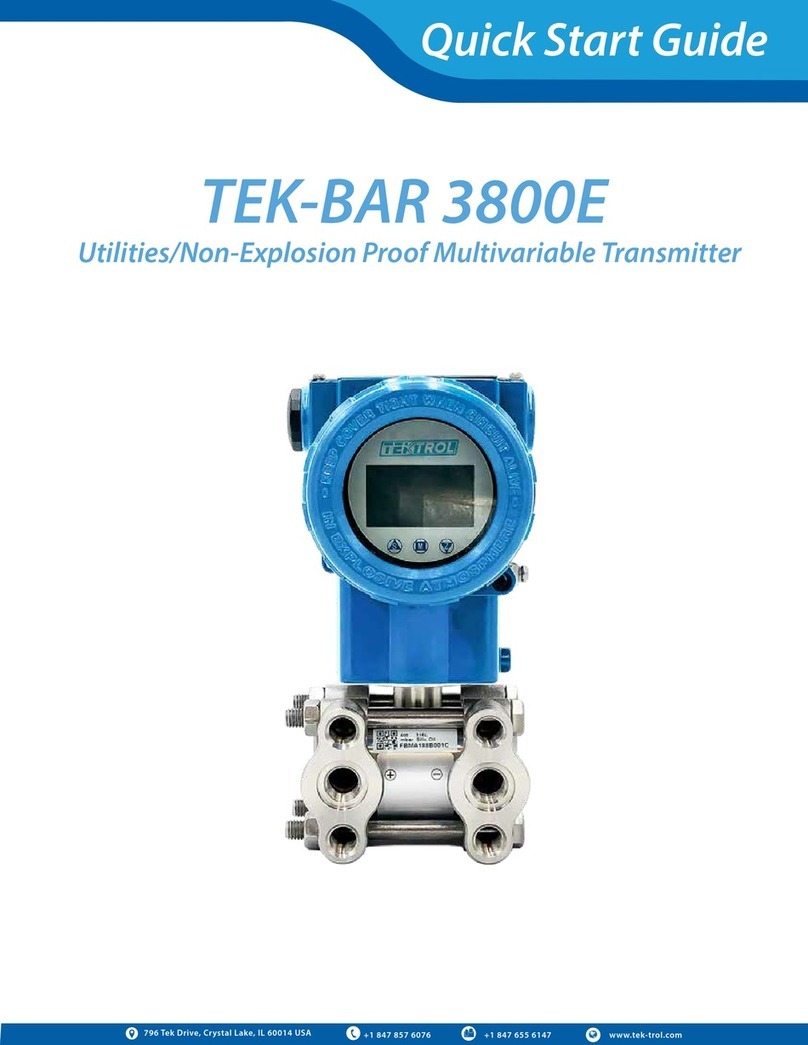
Tek-Trol
Tek-Trol TEK-BAR 3800E User manual
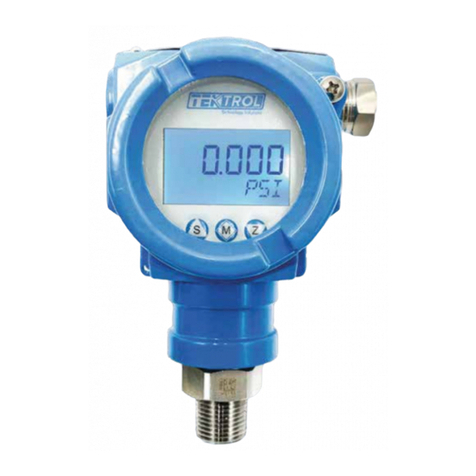
Tek-Trol
Tek-Trol TEK-BAR 3120B Series User manual
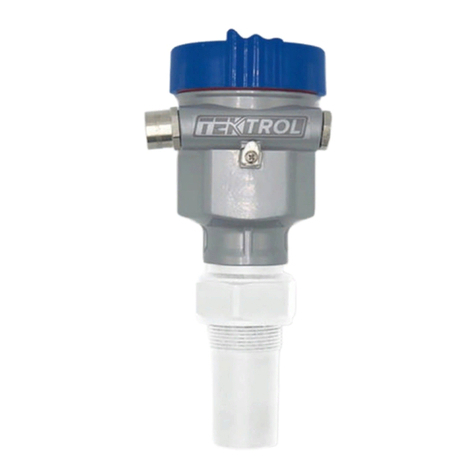
Tek-Trol
Tek-Trol Tek-Sound 4200B User manual
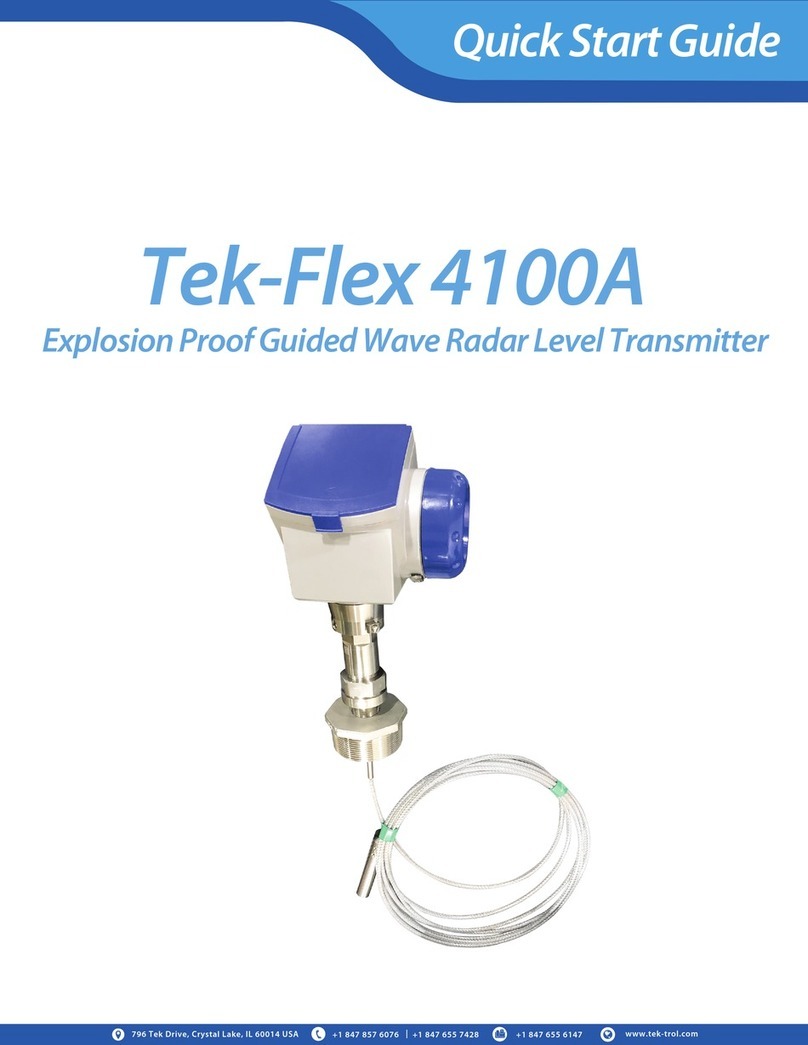
Tek-Trol
Tek-Trol Tek-Flex 4100A User manual



